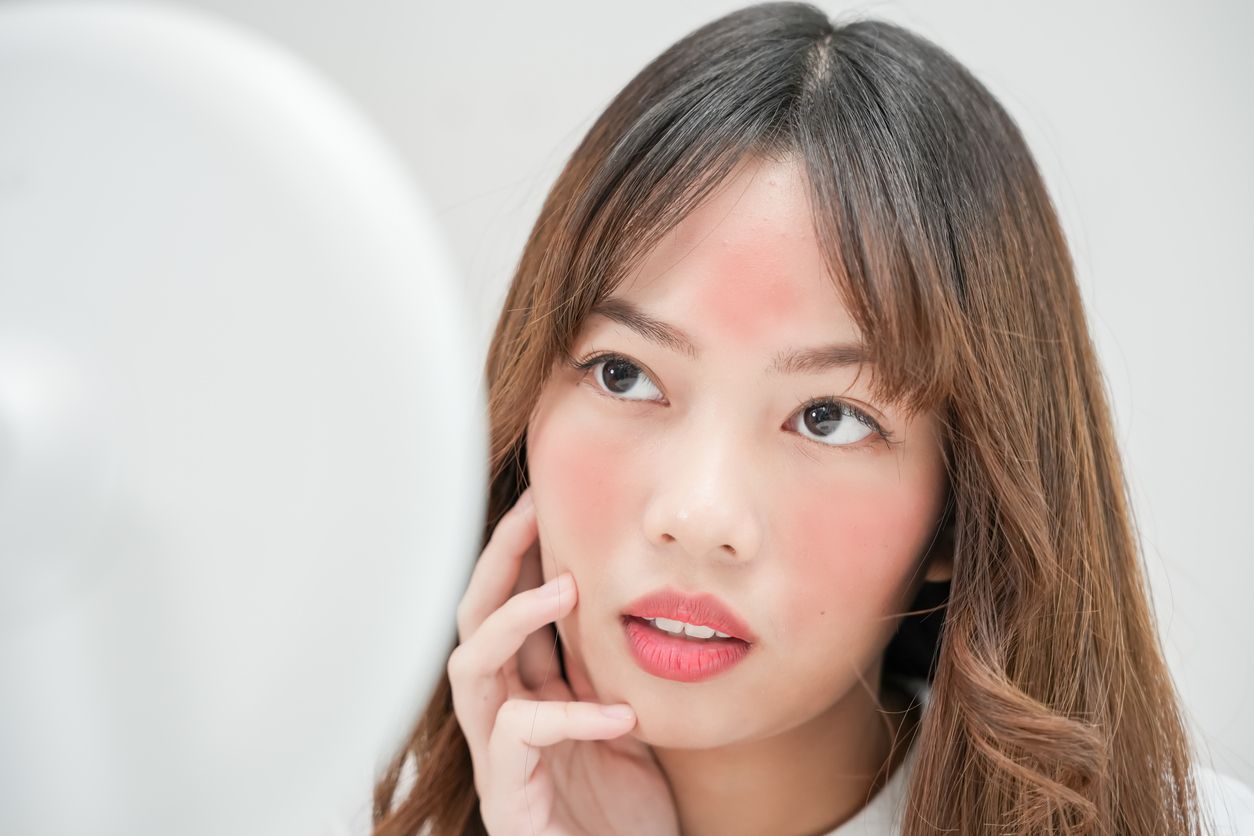- Home
- Trend
- Weight Loss Strategies
- Acne Tips
- Hair Health Information
- Blemish Removal Tips
- Acne Scar Removal Tips
- Muscle Building Techniques
- Intimate Care Tips
- Postpartum Intimate Care
- Eye Bags Wiki
- Tips for Face Slimming
- Secret of Permanent Hair Removal
- Breast Enlargement Tips
- Cure to Snoring
- Marionette Lines
- Skin-Tightening Secrets
Find out what causes facial redness and rosacea, their symptoms and tips that you can use to soothe your skin.
Understanding Your Skin: Is Facial Redness = Sensitive Skin?

Sensitive skin isn’t a skin type, but rather an unstable skin condition. When the skin’s barrier is compromised and loses its ability to protect against external irritants, it becomes prone to sensitivity reactions.
4 Common Symptoms of Skin Sensitivity:
• Dryness and peeling
• Redness, stinging, or burning sensations
• Itching and swelling
• Rashes or small bumps
The Real Reasons Behind Facial Redness: 3 Major Causes

Facial redness can be broken down into three broad categories: physiological, pathological, and external/environmental factors.
1. Physiological Causes:
• Emotional stress: Nervousness, embarrassment, or anger can trigger the sympathetic nervous system and cause blood vessels to dilate, leading to facial flushing.
• Temperature changes: Sudden shifts between hot and cold (like seasonal changes) can cause blood vessels to rapidly contract or dilate, resulting in redness.
• Alcohol or spicy food: These stimulate circulation and oil secretion, often making redness worse.
• Exercise: Intense workouts raise body temperature and boost blood circulation, which can lead to temporary facial redness.
2. Pathological Causes:
• Rosacea: A chronic inflammatory skin condition linked to immune dysfunction. Common symptoms include persistent redness, visible blood vessels, and bumps.
• Seborrheic dermatitis: Often occurs in areas with active oil glands (like the face and scalp), with redness, flaking, and itching.
• Atopic dermatitis (eczema): Triggered by immune imbalances, genetics, and allergens like dust mites, causing redness, itching, and swelling.
• Contact dermatitis: Caused by irritants or allergens (e.g. certain skincare products or cleaning agents), resulting in redness, itching, and sometimes blisters.
3. Other External Factors:
• Sun exposure: UV rays weaken the skin barrier, increasing sensitivity and the likelihood of redness.
• Over-exfoliation: Excessive or improper exfoliation damages the skin barrier, leaving it vulnerable to irritation.
• Irritating skincare products: Products with alcohol, fragrance, or preservatives can disrupt the skin’s natural defense, triggering sensitivity.
• Diet and lifestyle: A high-sugar or high-fat diet and lack of sleep can compromise skin health, indirectly causing redness and sensitivity.
Who's More Prone to Sensitive, Red Skin? Watch Out if You’re One of These 3 Groups:
• Genetics: Fair skin, thin skin, or a family history of sensitivity.
• Environmental & lifestyle habits: Excessive UV exposure, poor sleep routines, and high stress levels.
• Improper skincare: Using irritating products or over-cleansing/exfoliating.
免費體驗
Acne Treatment
1 Minute Self-Registration
Date should not be before minimal date
Emergency Soothing Tips for Sensitive Skin: 3 Key Tactics
Rapid Relief: Cool Down and Reduce Redness Fast
• Cold compress: Use a chilled towel or cloth soaked in cold water, apply to the face for 5–10 minutes.
• Facial mist: Use a simple, hydrating mist to replenish moisture anytime.
• Avoid irritants: Immediately stop using any skincare or makeup that may irritate, and stay away from known allergens.
Diet Adjustments: Cut Out Trigger Foods
• Avoid alcohol, spicy foods, and caffeine: These widen blood vessels and can worsen facial redness.
• Drink more water: Proper hydration supports healthy skin function.
• Add antioxidants like vitamins C and E: These help protect the skin from oxidative stress and damage.
Control Your Environment: Indoor Humidity Matters
• Use a humidifier: Prevent dry air from dehydrating your skin and aggravating sensitivity.
• Avoid extreme temperatures: Hot or cold environments can cause sudden blood vessel contractions and flare-ups.
6 Daily Skincare Basics to Protect Your Skin Barrier and Say Goodbye to Redness
1. Cleansing: Gentle and Minimal
• Choose mild, non-irritating cleansers: Avoid products with soap bases, alcohol, or artificial fragrances.
• Avoid scrubs and exfoliating products: Over-cleansing can damage the skin barrier and worsen sensitivity.
• Use lukewarm water: Hot water strips the skin of its natural oils, leading to dryness.
• Massage gently: Use your fingertips to lightly massage your face—never rub or scrub harshly.
2. Moisturizing: Reinforce and Repair the Skin Barrier
• Opt for simple formulas free of alcohol, fragrance, and preservatives: These ingredients are common irritants.
• Look for ingredients like ceramides, hyaluronic acid, and glycerin: These help restore and strengthen the skin’s natural moisture barrier.
• Incorporate moisturizers, creams, and hydrating masks: Choose products based on your skin type and hydration needs.
3. Skin Repair: Soothing Serums for Sensitive Skin
• Choose serums with calming and healing ingredients like Centella Asiatica, chamomile, or aloe vera: These reduce inflammation and promote recovery.
• Rebuild skin resilience: A strong skin barrier is the first line of defense against external irritants.
4. Sun Protection: A Key Step in Sensitivity Prevention
• Use physical sunscreens with gentle ingredients: Look for zinc oxide or titanium dioxide, which are less likely to trigger sensitivity.
• Wear sunscreen indoors too: UV rays can penetrate windows and still damage your skin.
• Choose SPF 30 or higher: Higher SPF provides better protection.
5. Ingredient Selection: Avoid Harsh Formulas, Embrace Gentle Ones
• Steer clear of common irritants: Alcohol, fragrances, dyes, parabens, and SLS/SLES are known to trigger skin reactions.
• Favor natural and gentle botanicals: Ingredients like chamomile, aloe vera, and Centella Asiatica are ideal for sensitive skin.
6. Skincare Routine: Simplify to Minimize Irritation
• Morning routine: Gentle cleanser → toner → serum → moisturizer → sunscreen
• Evening routine: Gentle cleanser → toner → serum → moisturizer
• Use masks sparingly: Over-masking can lead to excessive hydration, which may burden the skin. Stick to simple, non-irritating formulas.
When to See a Doctor?
If your facial redness and sensitivity are severe, disrupt your daily life, or don’t improve with self-care, it’s time to consult a dermatologist. They can perform diagnostic tests and may prescribe topical medications, oral treatments, or laser therapy tailored to your condition.
Skin issues can be frustrating. While the above methods can help soothe redness and sensitivity, Hong Kong’s fast-paced lifestyle may not allow for every step. If you’re looking for a more efficient solution, medical aesthetics could be the answer.
Redness That Won’t Go Away? Try Perfect Medical’s Acne Treatment—Painless, Non-Invasive Relief for Sensitive Skin
Can’t figure out what’s causing your redness? Feel lost managing sensitive skin? Don’t panic! Here’s a recommendation: Perfect Medical’s Acne Treatment. Though primarily designed to target acne, redness, blemishes, blackheads, enlarged pores, dehydration, and dull skin, its pain-free and non-invasive nature makes it ideal for sensitive skin too—instantly calming discomfort and heat.
This high-tech treatment combines dual-spiral suction drainage and vacuum dermabrasion. It gently softens dead skin, deeply cleans pores, and infuses purifying ingredients to stimulate collagen from within. The result? Clearer, calmer, and more balanced skin.
Sign up now to enjoy a professional skin analysis + a session of the Perfect Medical Acne Treatment!
Experience Now: Acne Treatment免費體驗
Acne Treatment
1 Minute Self-Registration
Date should not be before minimal date
FAQ

What are the treatment options for skin sensitivity?
Treatment depends on your individual condition. Dermatologists may prescribe steroid creams or hormone-based medications—but always use them under medical supervision.
What are the symptoms of sensitive skin?
Redness, itching, stinging, or burning sensations are signs your skin barrier may be compromised, possibly leading to dermatitis or allergic reactions. It’s important to identify and avoid triggers quickly.
Is facial redness always caused by rosacea?
Rosacea can cause redness, but it’s not the only possible cause. It’s best to consult a specialist for an accurate diagnosis.
How do dust mites cause redness?
These tiny, invisible organisms can trigger inflammation, leading to redness as a skin sensitivity response.
Can using the wrong skincare product cause red cheeks?
Yes! This doesn’t mean the product is bad—it might simply contain ingredients that don’t suit your skin’s unique needs.









